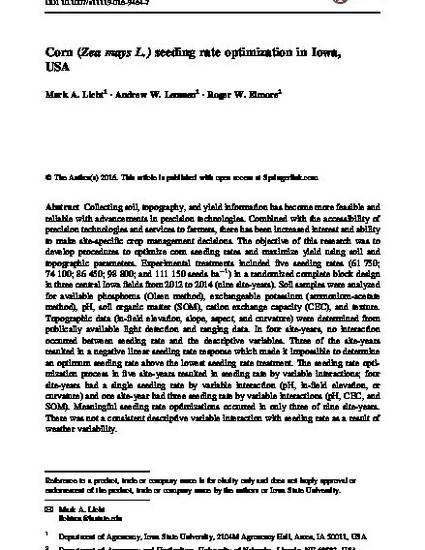
Collecting soil, topography, and yield information has become more feasible and reliable with advancements in precision technologies. Combined with the accessibility of precision technologies and services to farmers, there has been increased interest and ability to make site-specific crop management decisions. The objective of this research was to develop procedures to optimize corn seeding rates and maximize yield using soil and topographic parameters. Experimental treatments included five seeding rates (61 750; 74 100; 86 450; 98 800; and 111 150 seeds ha−1) in a randomized complete block design in three central Iowa fields from 2012 to 2014 (nine site-years). Soil samples were analyzed for available phosphorus (Olsen method), exchangeable potassium (ammonium-acetate method), pH, soil organic matter (SOM), cation exchange capacity (CEC), and texture. Topographic data (in-field elevation, slope, aspect, and curvature) were determined from publically available light detection and ranging data. In four site-years, no interaction occurred between seeding rate and the descriptive variables. Three of the site-years resulted in a negative linear seeding rate response which made it impossible to determine an optimum seeding rate above the lowest seeding rate treatment. The seeding rate optimization process in five site-years resulted in seeding rate by variable interactions; four site-years had a single seeding rate by variable interaction (pH, in-field elevation, or curvature) and one site-year had three seeding rate by variable interactions (pH, CEC, and SOM). Meaningful seeding rate optimizations occurred in only three of nine site-years. There was not a consistent descriptive variable interaction with seeding rate as a result of weather variability.
Available at: http://works.bepress.com/mark-licht/6/

This article is forthcoming in Precision Agriculture (2016), doi:10.1007/s11119-016-9464-7. Posted with permission.